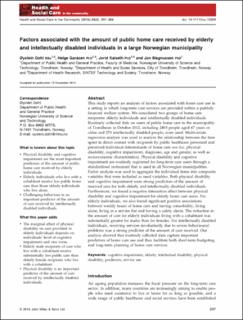| dc.contributor.author | Døhl, Øystein | |
| dc.contributor.author | Garåsen, Helge | |
| dc.contributor.author | Kalseth, Jorid | |
| dc.contributor.author | Magnussen, Jon | |
| dc.date.accessioned | 2021-02-12T11:19:42Z | |
| dc.date.available | 2021-02-12T11:19:42Z | |
| dc.date.issued | 2016 | |
| dc.identifier.citation | Døhl, Øystein, Garåsen, Helge, Kalseth, Jorid, & Magnussen, Jon. (2016). Factors associated with the amount of public home care received by elderly and intellectually disabled individuals in a large Norwegian municipality. Health & Social Care in the Community, 24 (3), 297-308. | en_US |
| dc.identifier.uri | https://hdl.handle.net/11250/2727704 | |
| dc.description.abstract | This study reports an analysis of factors associated with home care use in a setting in which long‐term care services are provided within a publicly financed welfare system. We considered two groups of home care recipients: elderly individuals and intellectually disabled individuals. Routinely collected data on users of public home care in the municipality of Trondheim in October 2012, including 2493 people aged 67 years or older and 270 intellectually disabled people, were used. Multivariate regression analysis was used to analyse the relationship between the time spent in direct contact with recipients by public healthcare personnel and perceived individual determinants of home care use (i.e. physical disability, cognitive impairment, diagnoses, age and gender, as well as socioeconomic characteristics). Physical disability and cognitive impairment are routinely registered for long‐term care users through a standardised instrument that is used in all Norwegian municipalities. Factor analysis was used to aggregate the individual items into composite variables that were included as need variables. Both physical disability and cognitive impairment were strong predictors of the amount of received care for both elderly and intellectually disabled individuals. Furthermore, we found a negative interaction effect between physical disability and cognitive impairment for elderly home care users. For elderly individuals, we also found significant positive associations between weekly hours of home care and having comorbidity, living alone, living in a service flat and having a safety alarm. The reduction in the amount of care for elderly individuals living with a cohabitant was substantially greater for males than for females. For intellectually disabled individuals, receiving services involuntarily due to severe behavioural problems was a strong predictor of the amount of care received. Our analysis showed that routinely collected data capture important predictors of home care use and thus facilitate both short‐term budgeting and long‐term planning of home care services. | en_US |
| dc.publisher | Health & Social Care in the Community | en_US |
| dc.subject | cognitive impairment | en_US |
| dc.subject | elderly | en_US |
| dc.subject | intellectual disability | en_US |
| dc.subject | physical disability | en_US |
| dc.subject | predictors | en_US |
| dc.subject | service use | en_US |
| dc.title | Factors associated with the amount of public home care received by elderly and intellectually disabled individuals in a large Norwegian municipality | en_US |
| dc.type | Journal article | en_US |
| dc.source.pagenumber | 297-308 | en_US |
| dc.source.volume | 24 | en_US |
| dc.source.journal | Health & Social Care in the Community | en_US |
| dc.source.issue | 3 | en_US |
| dc.identifier.doi | https://doi.org/10.1111/hsc.12209 | |
| dc.description.localcode | måsjekkes | |
